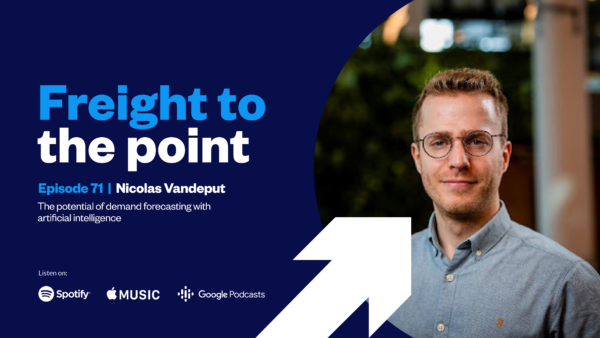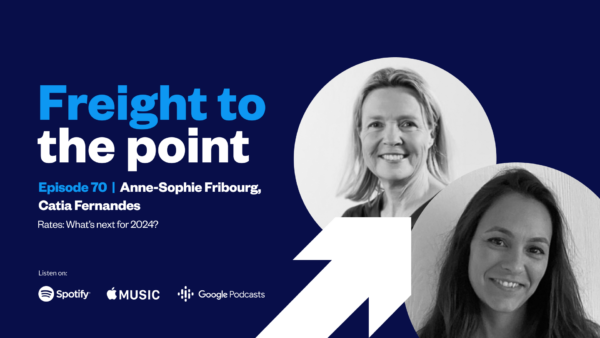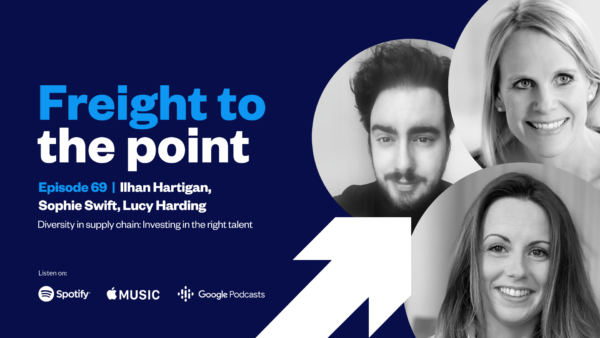Episode 72:
The Red Sea Crisis
See all episodes

In the latest episode of Freight to the Point, we’ve featured our most recent webinar, recorded on 10th January on the Red Sea Crisis. Carriers have suspended vessels from passing through the Bab al-Mandab strait after the recent attacks by the Houthis which has had implications for the shipping industry.
Our experts, Anne-Sophie Fribourg, VP of Ocean and Catia Fernandes, Head of Trade Asia and IPAK – Europe and Intra-Europe, share their insights on the repercussions of the crisis on:
- Rates
- Transit times
- Equipment
- Capacity
Discover how shippers should work with their freight forwarders and adapt their strategies to mitigate risks in their supply chain. From rate negotiations to pushing shipments back to a later date, stay informed on the latest developments by listening to this insightful episode.
Resources
Watch the full webinar: https://content.zencargo.com/redsea-crisis-video
Catia Fernandes:
I am Catia Fernandes, Head of Asia-Europe Trade at Zencargo. And I’m joined by Anne-Sophie Fribourg, VP of Ocean. Today, we will be speaking to you about what’s been happening in the Red Sea and how it will impact your shipments.
But before we get started with this session, let me just run through some housekeeping rules. So we’re running this webinar as a Google Meet event, and while you can see and hear us, we cannot see or hear you. You can, however, get in touch with us through the Q&A feature in the form of Slido. The link to the Q&A chat, yes, as you can see, has just been pasted on the chat, and you can submit your questions through there. We want the session to be as interactive as possible, so feel free to share your questions throughout the event by using the Q&A function in Slido. And we will have some time dedicated to those questions towards the end. Finally, if you have any problems with your connection, then contact the team at marketing@zencargo.com, also there in the chat.
Okay, so let’s get started. As mentioned, I’m Catia, and I work in the procurement department at Zencargo, managing the ocean products for Asia-Europe, for both eastbound and westbound, and managing also India subcontinent and Middle East to Europe, as well as into Intra-Asia and Intra-Europe. On these straits, I ensure that we can offer the best suited products to fit the needs of our customers. And I’m obviously helped by a great team and, of course, Anne-Sophie who will introduce herself as well.
Anne-Sophie Fribourg:
Hi, everybody, and very happy to welcome you. Thanks, Catia. So I’m Anne-Sophie Fribourg, in charge of ocean freight for Zencargo. And I have a long experience in the industry, having worked for a freight forwarder for many years before, a more traditional freight forwarder. And I’d like to say that in this industry, as we can see now, nothing is certain, nothing can be predictable. And this is exactly what we are seeing now and we’re going to discuss about it.
So we will start with the first slide. Yeah, so what’s happening and what’s going on? Very quickly, you’ve all been reading the press and we know that the Red Sea’s facing escalating attacks from the Houthi rebels in Yemen on commercial ships owned by the worldwide shipping lines, using drones, missiles, and even attempts to board ships. And this is lasting since a few weeks now. It is a strategic area, and as we see on the map, the Bab al-Mandab Strait is a strategic point, linking Europe to Asia and to Africa. And the Suez Canal is a major route, with close to 20,000 vessels transiting every year. And I was gathering 12% of the global trade so it is a strategic route.
All these attacks on some of the shipping line ships have conducted the carriers to review positions. First of all, removing their ships in safe waters, and then rerouting ships via the Cape of Good Hope, circumnavigating the African continent, in order to access the south of Europe and then Northern Europe. And which is in fact the old route before the Canal Suez constructions. So Catia will give you now the details of how shipping lines have organised themselves, knowing that they’ve had various strategies. What I’d like to add is, as I said, we are now day 26 after the crisis started. And the situation in terms of safety in the whole area remains unchanged. There has been some isolated incidents during the last weekend, but with no signs of attacks.
There is a military coalition led by the USA with 20 nations joining it, called the Operation Prosperity Guardian, supposed to be in charge of ensuring the safety in the area. For the time being, we have not seen a lot of improvement from their discussions or negotiations at high level.
More notably, what we’ve seen is some countries like France have deployed some naval ships from their Army to serve their national interests and to protect the French shipping lines, CMA CGM, which is today one of the few shipping lines going through the canals, escorted by the French Army. So whether Operation Prosperity Guardian will be a success, no one knows. Will it bring carriers to resume the passage in Suez, it is still too early to say. Hitting the news yesterday, we heard that some shipping lines are negotiating directly with the Houthi rebels, but that might be a rumour, no one knows. So, Catia, I’ll let you explain what is the situation per shipping line.
Catia Fernandes:
Yeah, so basically what are we seeing? We’re seeing that some carriers in the past couple of weeks have continued to route certain vessels through the area while others, as Anne-Sophie said, took immediate action to reroute via the Cape of Good Hope. So following the recent attack that happened on the Maersk Hangzhou on the 2nd of January, Maersk, for example, decided to pause all transits through the Red Sea. And this was a decision they took after they had just recently started transiting through the Red Sea. So that tells you how much things change and how carriers keep assessing the situation. Other carriers such as Hapag-Lloyd, Evergreen, Yang Ming, Hyundai, MSC, they’re all rerouting their vessels through the Cape of Good Hope. MSC we know is the largest carrier in the world and, therefore, is in a better position to manage their fleet, to add additional vessels if they need to cope with… Increase the routings that they are having.
On the other hand, CMA and COSCO are the ones that openly continue to route, not all, but some of the vessels via the Suez Canal. As Anne-Sophie said, they have the support of the French Navy, which they are using. And we can say that for COSCO they basically are taking advantage that the rebels have not attacked yet any Chinese owned vessels.
Another piece of information that is important is that we know that carriers also decide to turn off their AIS signals, so the signal that locates them. And they do that when they’re in the region, just to ensure extra protection. So there might be vessels from carriers that have announced they’re not transiting through the Suez that might be transiting through the Suez. And there might be more vessels from CMA, for example, transiting through the area that we cannot see and cannot locate because they’re turned off, basically. So that’s a point to consider. Handing back to you, Anne-Sophie, on how would this impact our customers, and you, as people who ship through this difficult period?
Anne-Sophie Fribourg:
Yeah. So I’d like to talk about the diversions impact, which is huge, in fact, in terms of many aspects of the shipping. The first impact that we’ve all seen is the longer transit time that we are facing by using ships that are going through the Cape of Good Hope. That adds, an average, because it depends on the ship size, it depends on the route, it depends on the ports of call, but basically it’s adding between 10 to 20 days on Asia-Europe and Europe-Asia side. So which is, of course, much longer and which has, I would say, a second impact is the restriction of capacity overall on the trade. What we estimate is that there is a reduction of about 30% of the global capacity because shipping lines, in order to cover schedules on a round trip, would need to add four vessels if they want to secure the same schedules. So they would need to add four vessels to the usual 12 vessels on the route.
So less capacity overall, which brings to another impact which is space. Space is becoming extremely tight. There were some blank sailings already done by the shipping lines so it is quite hard to find space since, I would say, Christmas, and that is increasing if we reach the middle and the end of the month. We see also an impact on equipment. Shipping lines have difficulties to repatriate empties in Asia and, therefore, some shipping lines tend to skip the northern ports of call in China to try to keep their schedules on time. Therefore, they would skip the northern ports, and that would mean a shortage of empties in mainly 20-foot, and 40-feet as well, in the main northern ports in China.
And the other impact that we will start to see quite soon is possible congestion at the European ports. Why? Because calls might overlap. There is an uncertainty in the ETA of the ships. There is an uncertainty in the respect of the berthing windows. And we see as well, as an impact, that the export calls will also be disrupted. Without forgetting the fact that there is an impact on export trades because some carriers favour repatriation of empties than full containers. So that is also restricting the capacity on the export trade.
In terms of rates and cost, first of all, I’d like to say, for carriers, there is an impact in the cost by using the new route. Why? Because if we calculate roughly, or what we know is that the passage of a 20,000 TEU ship in the cost is about $600,000. But the cost of rerouting via Good Hope is about $1 million. So there is definitely higher cost for the shipping line. But what we have seen is that shipping lines have been increasing rates in a very significant way through different surcharges. We’ve seen first, peak season surcharges, which is a usual surcharge that we see in the pre Chinese New Year period. But on top of that, there has been some emergency contingencies surcharge. All types of surcharge that are now being implemented, as well as GRIs. That is mainly affecting the customers, affecting you.
And the second impact is that there’s a snowball impact. Shipping lines have also increasing rates on other trades than on the trades concerned by the Red Sea issue. So it looks like the year 2024 was supposed to be, if we go back to early December, though there was a surge in demand, the year was supposed to be quite steady. And we see now that we are facing extremely high cost that we have to deal with. As well as the other impact I’d like to mention is that we might foresee some elevated cost in terms of detention and demurrage, if there are congestions in the ports. And shipping lines will surely, they started to do it partly, reduce the free time because they want their equipment. They want to have the availability of equipment as quick as they can. So in terms of rates, Catia will give you a more detailed picture per main trade.
Catia Fernandes:
Yes. So in terms of rates, what we’ve seen, the increases are obviously quite substantial, as Anne-Sophie said. And the increases, obviously, are linked to rates that basically can get you space as well. So some rate increases sound like quite severe but that is what you expect to pay if you want to load your cargo during January. So we compare the first week of January with the first week of December. You can see per trade that there’s basically Far East, Europe, eastbound and westbound, it’s nearly you pay now three times more than you used to. And despite other trades, like the Far East, US, either east coast or west coast, especially west coast, that doesn’t transit through the Suez, it has a collateral effect when one trade is severely under pressure it affects other trades as well. And, therefore, the carriers increase the rates because of that. So you can see there that the ranges are between 90% to 300%, compared to one month ago, which is quite substantial.
So I wanted to now push towards the next point which is, what should you do? So what should you do, and how should you work with your freight forwarder? First, you should quantify the impact. You should work closely with your partner to know exactly the scale of your disruption. And your account managers that you work within the freight forwarders should be talking to you daily.
Second, you should be planning for costs. You need to be aware of how this could affect any negotiations. And you need to be ready to manage timelines to balance security and flexibility. It is important to understand where the rate market is, and the possible changes to, for example, free time that carriers impose which is affecting detention and demurrage costs.
Third, you need to model the lead time impact, so with the equipment shortages and rerouting, space and loading will be even more unreliable. You need to review, basically, your planned buffer times and stocks to quantify the risks. For example, you need to assess if anything can be pushed post Chinese New Year when the demand might be lower, for example.
And, finally, prioritise your SKUs. You need to find affected products, calculate the potential shortfalls, to determine a contingency plan for those SKUs at risk. Contingency plans here can mean anything from other modes of transport such as sea-air, or rail, but you should be working with your freight forwarder to understand what options best suit your needs. So, Anne-Sophie, back to you.
Anne-Sophie Fribourg:
Yep. So how can we help you more? And Catia has given you a list of advice or recommendation but I would really encourage you, and we are offering a bespoke 1:1 rate strategy across January. We are available for that. And I think we have to remain very close. We are realising, through this new black swan event, that risk is always here. And that in order to ensure that the efficiency of supply chain, agility and flexibility are key to be on top of the problems and to be on top of solutions. We have a team dedicated to the crisis, on top of every booking, every day, either in China or in Europe, talking to the shipping lines. We have strategic conversations with shipping lines but we also have conversations, I would say, for one single container. Because we know that we need to satisfy our customers and be very close to you as much as we can.
We encourage proactive discussion on how to avoid, I would say, a one-size-fits-all approach, ensuring that we both monitor the risk on short-term and also factor in long-term business goals. This is very important and we need your help, we need your contribution, we need collaboration. We have a premium offer with guaranteed space and equipment with our partners. We re-evaluate our location plans, according to your needs, on a daily basis. We can prioritise shipment. We can delay some shipments. But for this, we also need to work hand in hand. And, of course, we can provide intermodal options, such as sea-air, that we use via the Middle East, or even rail from China. For the time being, on rail, there are options. There is still capacity. And this is another offer we can discuss with you.

Episode 71: The potential of demand forecasting with artificial intelligence
In the most recent instalment of Freight to the Point, Lucie Phillips, Zen...

Episode 70: Rates: What's next for 2024?
As we prepare for the year ahead, it's crucial to consider the three pillars...

Episode 69: The Power of Diversity in the Supply Chain: Opportunities and Challenges
To make the right changes in an organisation, it's crucial to attract the ri...

